If you’re looking to open your subconscious in 2025, I recommend checking out the top dream symbol dictionaries available today. From biblically rooted guides to practical, visual, and all-encompassing resources, there’s something for everyone—whether you want spiritual insights or straightforward interpretations. These tools can help you understand symbols, signs, and messages that appear in your dreams. If you want to discover which ones suit your needs best, just keep exploring—more details are ahead.
Key Takeaways
- Explore biblically rooted dictionaries for spiritual and prophetic dream insights aligned with scripture.
- Consider practical, beginner-friendly guides for straightforward symbol identification and analysis.
- Use visual and aesthetic dictionaries to enhance engagement and understanding through illustrations and design.
- Evaluate features like organization, depth, and cross-references to select the most suitable dream interpretation resource.
- Balance personal needs—faith-based, practical, or visual—when choosing among the top dream symbol dictionaries for 2025.
Illustrated Dictionary of Dream Symbols: Biblical Guide
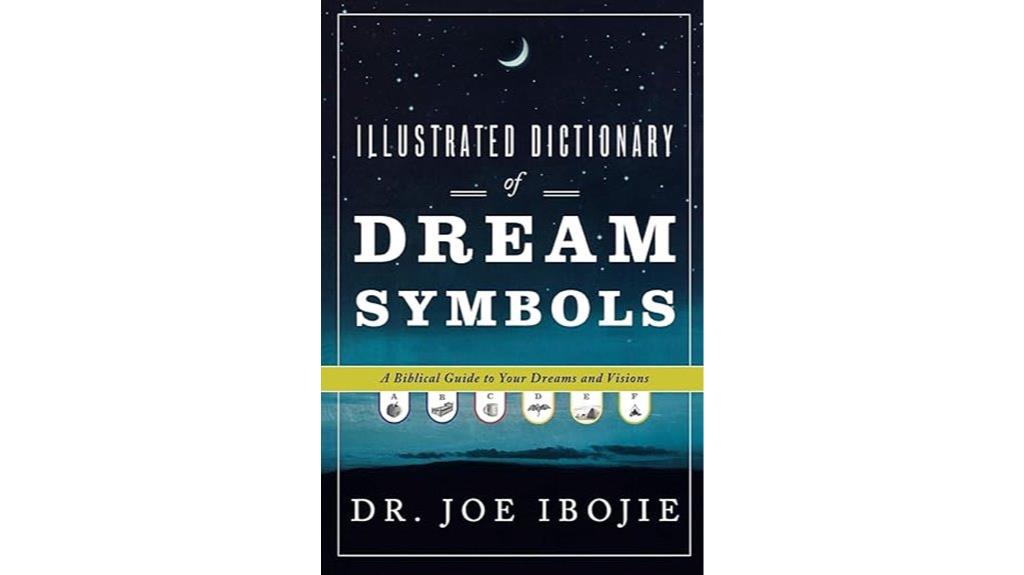
If you’re a Christian seeking to understand the spiritual messages behind your dreams, the Illustrated Dictionary of Dream Symbols: Biblical Guide is an excellent resource. I find it helpful because it offers biblical insights into dreams, visions, and symbols, emphasizing scripture and spiritual understanding. The book guides me to interpret dreams within their context, helping me recognize God’s messages. It covers various symbols like animals, colors, and numbers, with biblical references that deepen my insight. Though some definitions are broad, it encourages critical thinking and personal discernment, empowering me to interpret dreams confidently and see God’s voice in my subconscious messages.
Best For: Christians seeking a biblically grounded, accessible resource to interpret dreams, symbols, and visions with confidence and spiritual insight.
Pros:
- Provides biblical references and scripture support to enhance understanding of dream symbols.
- Encourages personal discernment and critical thinking in dream interpretation.
- User-friendly and beginner-friendly, making it easy for believers to grasp foundational concepts.
Cons:
- Some definitions of symbols are broad or vague, requiring additional personal analysis.
- Limited practical examples of specific dreams and detailed interpretations.
- Certain sections may be slow to start and could benefit from more illustrative, real-life dream scenarios.
A-Z Dream Symbology Dictionary by Dr. Barbie L. Breathitt (2015-05-04)
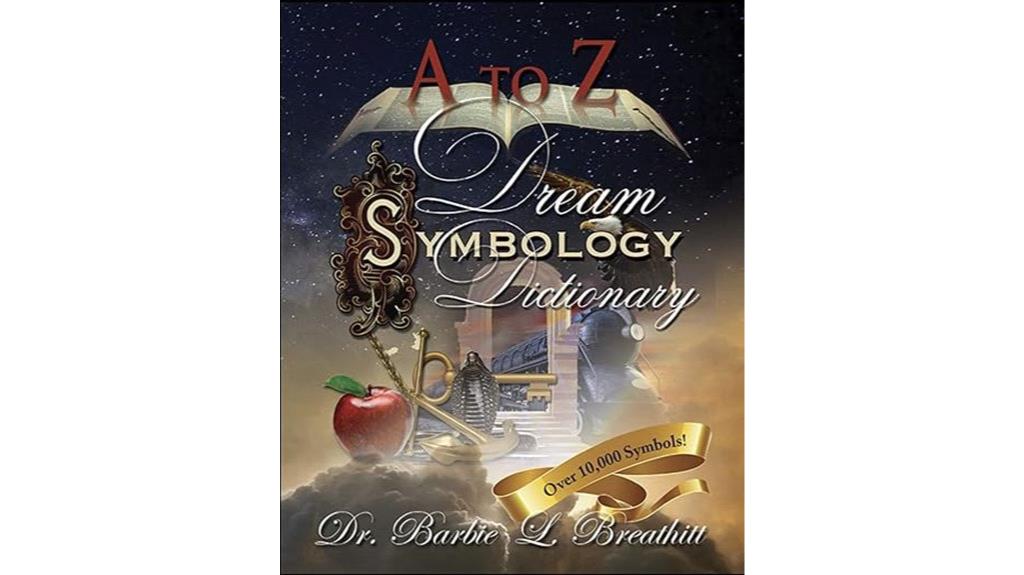
The “A-Z Dream Symbology Dictionary” by Dr. Barbie L. Breathitt is a valuable resource for Christians seeking biblical dream interpretation. I find it incredibly helpful for understanding spiritual messages, especially when dreams involve symbols like wolves, numbers, or walking alone. The book aligns symbols with scripture, offering deep insights grounded in biblical teachings. While it can be costly, many users, including myself, consider it worth the investment. It encourages prayer and Holy Spirit guidance, making it a trustworthy tool for deciphering God’s messages through dreams. Overall, it strengthens spiritual discernment and personal growth with practical, biblically-sound interpretations.
Best For: Christians seeking biblically grounded dream interpretation and spiritual guidance through symbols and numbers.
Pros:
- Provides deep, scripture-based insights aligning symbols with biblical teachings
- A comprehensive A-Z resource for interpreting a wide range of dream symbols and metaphors
- Encourages prayer and Holy Spirit guidance, enhancing spiritual discernment
Cons:
- Can be costly, with prices around $50 or more in some regions
- Some users report minor issues such as page cuts affecting definitions
- Requires familiarity with biblical context to fully benefit from interpretations
The Bible-Based Dictionary of Prophetic Symbols
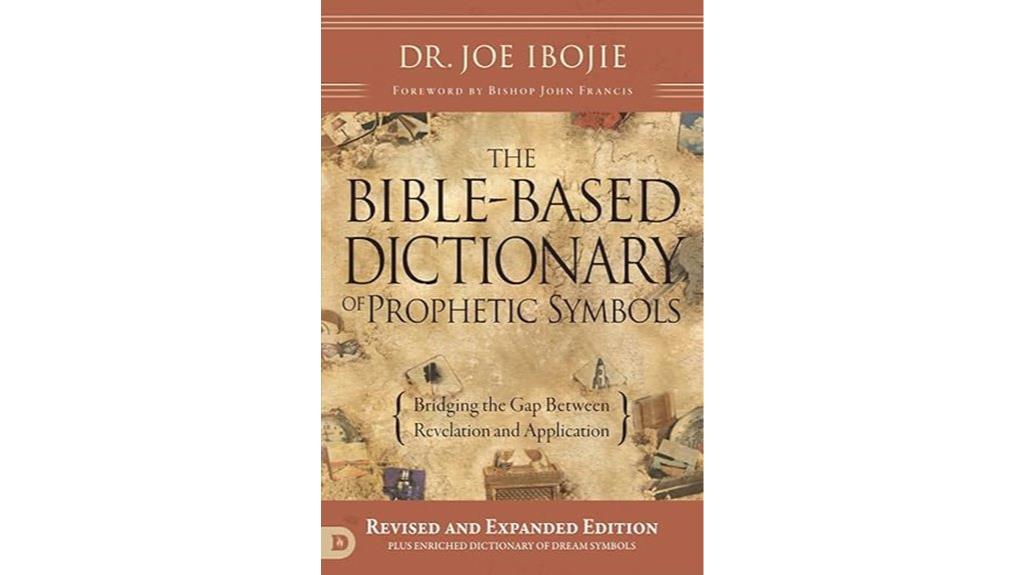
For anyone seeking biblically grounded dream interpretation, the Bible-Based Dictionary of Prophetic Symbols stands out as an essential resource. It’s deeply rooted in scripture, helping you decipher dreams and understand prophetic messages without mysticism or worldly spirituality. Although it’s not a quick-reference guide, its detailed explanations and biblical focus make it valuable for believers, dreamers, and those connecting dreams with scripture. The book encourages personal interpretation, emphasizing the Holy Spirit’s guidance. While some find its organization challenging, many appreciate its trustworthiness and depth. Overall, it’s a practical tool for anyone committed to biblical dream understanding and spiritual growth.
Best For: believers, dreamers, and anyone seeking biblically grounded insights into dreams and prophetic messages.
Pros:
- Fully rooted in scripture, ensuring biblically sound interpretations.
- Helpful for deepening understanding of spiritual revelations and prophetic symbols.
- Encourages personal interpretation guided by the Holy Spirit, fostering spiritual growth.
Cons:
- Not a quick-reference guide; requires effort and time to read and understand.
- Categorized by sections rather than alphabetically, which can make locating entries inconvenient.
- Some physical aspects, such as layout and quality, may be disappointing to users.
The Dream Interpretation Dictionary: Symbols, Signs, and Meanings
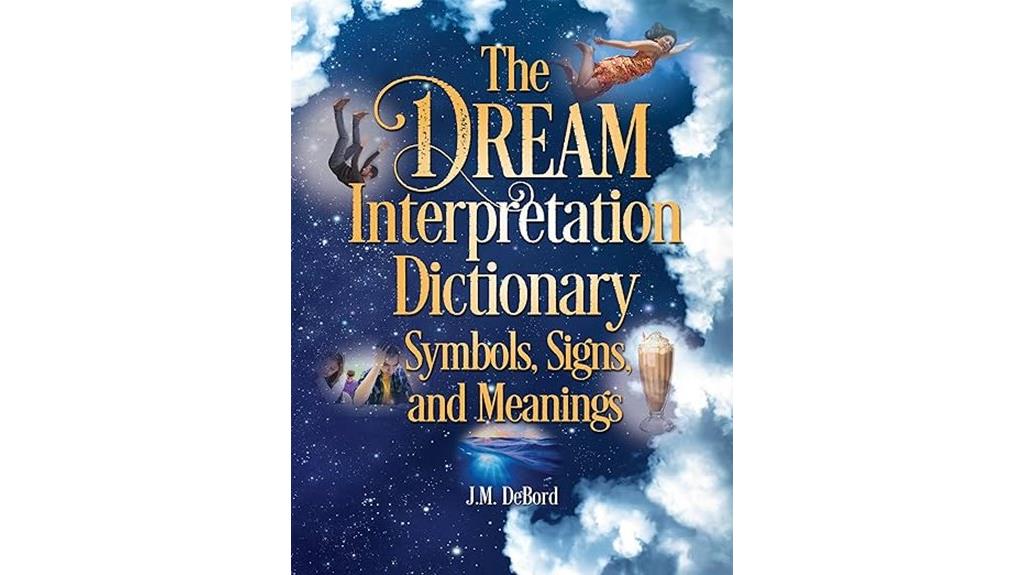
Anyone interested in revealing the hidden messages behind their dreams will find “The Dream Interpretation Dictionary” by J.M. DeBord invaluable. This book offers simple, accessible guidance for deciphering symbols, signs, and meanings in your dreams. Inspired by a lifelong fascination with dreams and fueled by DeBord’s insights from shows like Coast to Coast AM, I found it to be a practical resource for understanding subconscious signals. It helps identify symbols, colors, shapes, and patterns, making dream recall clearer and more meaningful. Whether you’re a beginner or experienced, this dictionary empowers you to interpret dreams confidently and uncover personal insights for growth and self-awareness.
Best For: individuals seeking an easy-to-understand, comprehensive guide to interpreting dreams and uncovering subconscious messages for personal growth.
Pros:
- Clear, accessible explanations suitable for beginners and experienced dreamers alike
- Helps improve dream recall by identifying symbols, colors, shapes, and patterns
- Provides practical insights that can enhance self-awareness and emotional understanding
Cons:
- Some entries may be repetitive or broad in scope
- Limited coverage of certain specific or niche dream symbols
- Physical copies may have long waiting times or limited availability
A-Z Dream Dictionary of Common Dreams
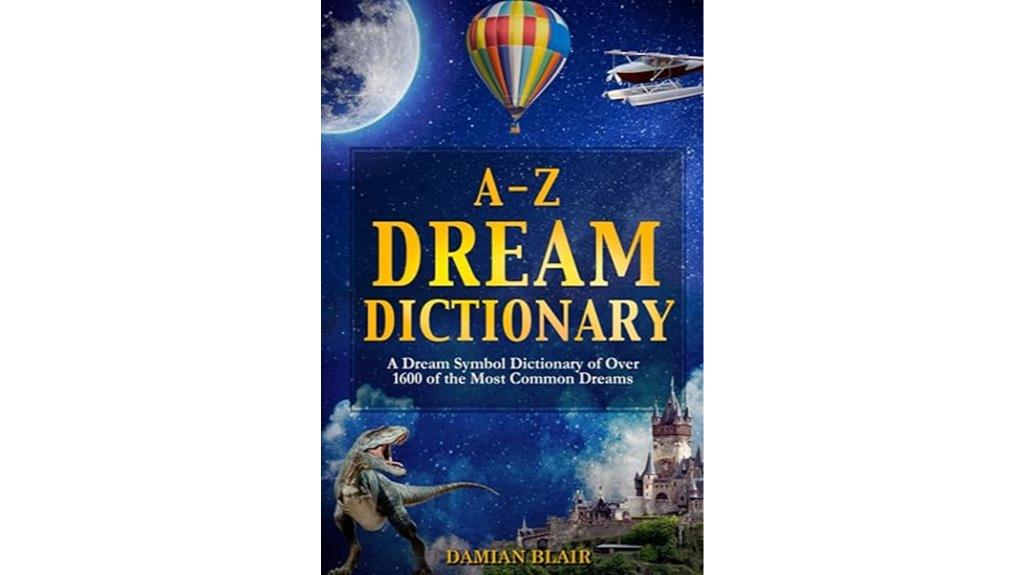
If you’re someone enthusiastic to decode common dreams quickly and confidently, the A-Z Dream Dictionary by Damian Blair is an ideal resource. It features over 1600 symbols, organized into 10 categories like nightmares, healing, and problem-solving, making navigation straightforward. The book provides practical tools, including a five-step analysis process and tips for journaling to improve recall. I find it especially helpful for identifying recurring themes and understanding symbols like teeth falling out, which often relate to loss or control. This dictionary makes dream interpretation accessible, engaging, and perfect for anyone interested in exploring their subconscious, whether for personal growth or mental clarity.
Best For: individuals interested in quickly decoding common dreams, exploring subconscious symbols, and seeking practical tools for personal growth or mental clarity.
Pros:
- Comprehensive coverage with over 1600 symbols across 10 organized categories
- User-friendly with practical tools like a five-step analysis process and journaling tips
- Makes dream interpretation accessible and engaging for beginners and casual dreamers
Cons:
- Some users find the interpretations lack depth or detailed explanations
- Not focused on spiritual or faith-based perspectives, limiting certain interpretive approaches
- Might be less suitable for advanced dream analysis or those seeking more exhaustive guidance
The Way of Dreams and Visions Symbol Dictionary 2017 Edition
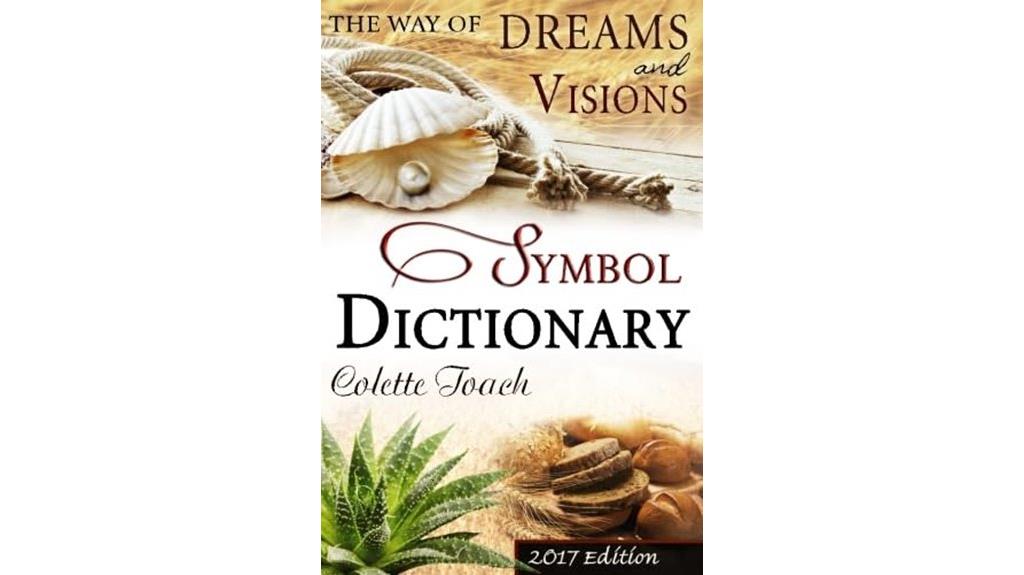
The Way of Dreams and Visions Symbol Dictionary 2017 Edition stands out as an essential resource for those seeking spiritual and biblical guidance in dream interpretation. I’ve found it incredibly helpful for decoding my dreams with biblical support and clear explanations. The author, inspired by the Holy Spirit, provides valuable insights that resonate deeply, helping me understand messages from my subconscious. Despite minor formatting glitches, I appreciate its depth and spiritual perspective. Many readers, including myself, consider it a must-have for interpreting dreams and gaining clarity on spiritual matters. It truly enriches the journey of understanding dreams through biblical and spiritual lenses.
Best For: individuals seeking biblically supported, spiritually insightful dream interpretation to better understand their subconscious messages.
Pros:
- Provides clear, biblically rooted explanations that deepen spiritual understanding.
- Authored by a spirit-inspired author, adding authenticity and spiritual credibility.
- Offers valuable insights that resonate with readers, aiding in personal growth and clarity.
Cons:
- Contains minor formatting issues such as upside-down pages and cut-off wording.
- Some readers may find the explanations too spiritual or specific to biblical references.
- The book’s focus on spiritual and biblical interpretation may not appeal to those seeking secular or psychological perspectives.
The Illustrated Bible-Based Dictionary of Dream Symbols
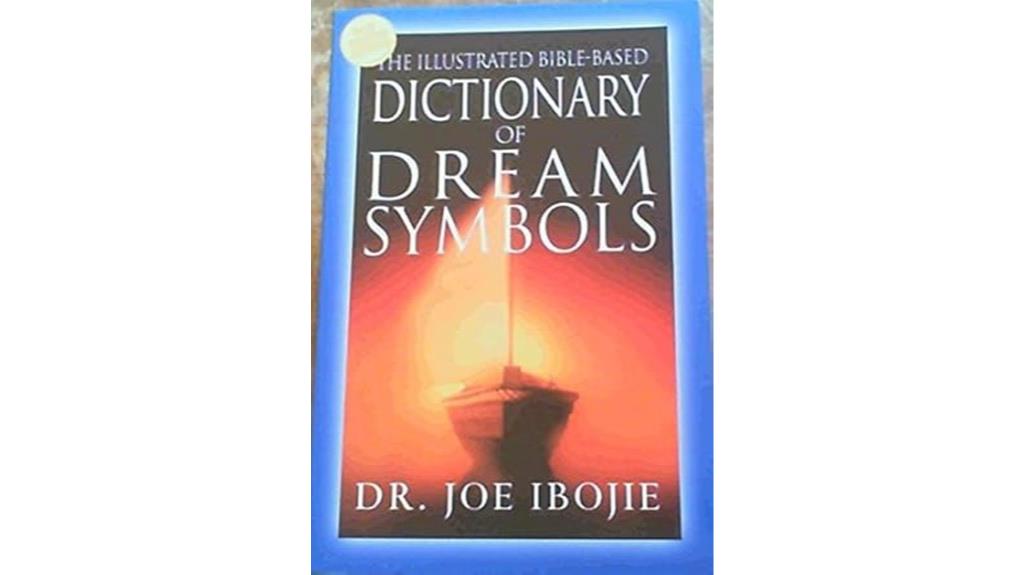
For those seeking biblical insight into their dreams, The Illustrated Bible-Based Dictionary of Dream Symbols stands out as an essential resource. I’ve found it incredibly insightful and helpful, packed with knowledge and beautifully written. Many users, including myself, appreciate its concise explanations and inspiring imagery, making it a joy to read. It’s considered the top choice for biblical dream interpretation, offering divine messages aligned with scripture. While it may not cover every common dream, its spiritual depth helps reveal what God might want to communicate through dreams. Overall, I highly recommend this dictionary for anyone wanting biblical clarity and spiritual understanding in their dream journey.
Best For: those seeking biblical and spiritual insight into dream symbols and interpretations rooted in scripture.
Pros:
- Highly insightful and well-written, offering concise explanations and inspiring imagery.
- Considered the top resource for biblical dream interpretation, providing divine messages aligned with scripture.
- Enhances understanding of dreams from a spiritual perspective, helping reveal what God may want to communicate.
Cons:
- May not cover all common or simple dreams, limiting its usefulness for some readers.
- Lacks coverage of basic or less spiritually focused dream topics.
- Not a comprehensive dream book for every type of dream, which could be disappointing for those seeking broader guidance.
The Womans Dictionary of Symbols and Sacred Objects
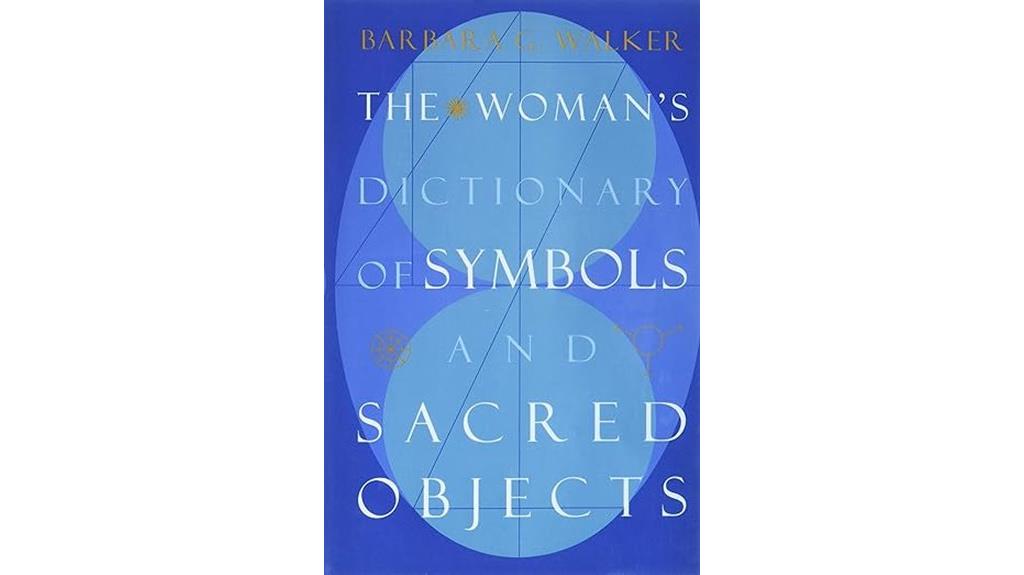
Anyone interested in uncovering the true, pre-patriarchal meanings behind symbols associated with women and goddess spirituality will find “The Womans Dictionary of Symbols and Sacred Objects” an invaluable resource. This all-encompassing guide highlights ancient symbols linked to women and the Earth Mother, emphasizing their natural, divine origins before patriarchal distortions. I appreciate how it challenges mainstream narratives, revealing how male-dominated histories have rewritten sacred imagery to promote control. The book’s organized sections on deities, signs, zodiac, and nature make it easy to explore deeper symbolism. It’s a powerful tool for anyone seeking to reconnect with goddess spirituality, feminine power, and authentic history.
Best For: those interested in exploring authentic, pre-patriarchal symbols of women and goddess spirituality to deepen their understanding of feminine divine history and esoteric knowledge.
Pros:
- Provides a comprehensive and organized overview of symbols related to women and the goddess across history.
- Challenges mainstream narratives, revealing the true pre-patriarchal meanings behind sacred imagery.
- An accessible resource for writers, artists, and spiritual seekers seeking to reconnect with goddess-centered traditions.
Cons:
- Minor issues with the book cover discrepancy that could cause initial confusion.
- The index could be more user-friendly with highlighted or emboldened key terms for quicker navigation.
- May be less detailed on mythological lore compared to more specialized texts, focusing instead on broad symbolism.
The Dream Bible: Dream Symbols Guide
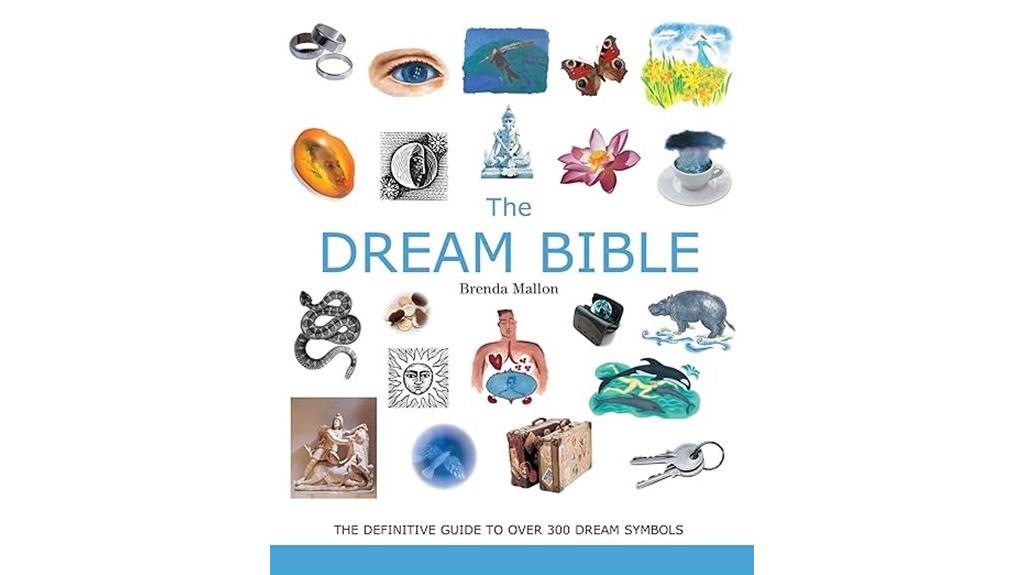
If you’re looking for a complete and easy-to-understand guide to over 300 dream symbols, The Dream Bible: Dream Symbols Guide is an excellent choice. I’ve found it to be a highly valuable reference, praised for its clear explanations and practical insights. Judy Hall’s series makes complex symbols accessible, making it perfect for learning or quick consultation. Though small print can be a challenge for those with poor eyesight, the book’s overall usefulness and positive reputation make it a worthwhile addition to any dream enthusiast’s collection. It’s especially handy for travel, offering quick access to meaningful interpretations on the go.
Best For: those seeking a comprehensive, easy-to-understand reference guide to over 300 dream symbols for learning, quick consultation, or travel use.
Pros:
- Highly praised for clear explanations and practical insights.
- Excellent for learning and quick reference, making complex symbols accessible.
- Compact and portable, ideal for travel and on-the-go consultations.
Cons:
- Small print can be difficult for readers with poor eyesight.
- Some users may find it less detailed for advanced dream analysis.
- Not suitable for those seeking in-depth psychological interpretation beyond symbols.
The Dictionary of Dreams Volume 2
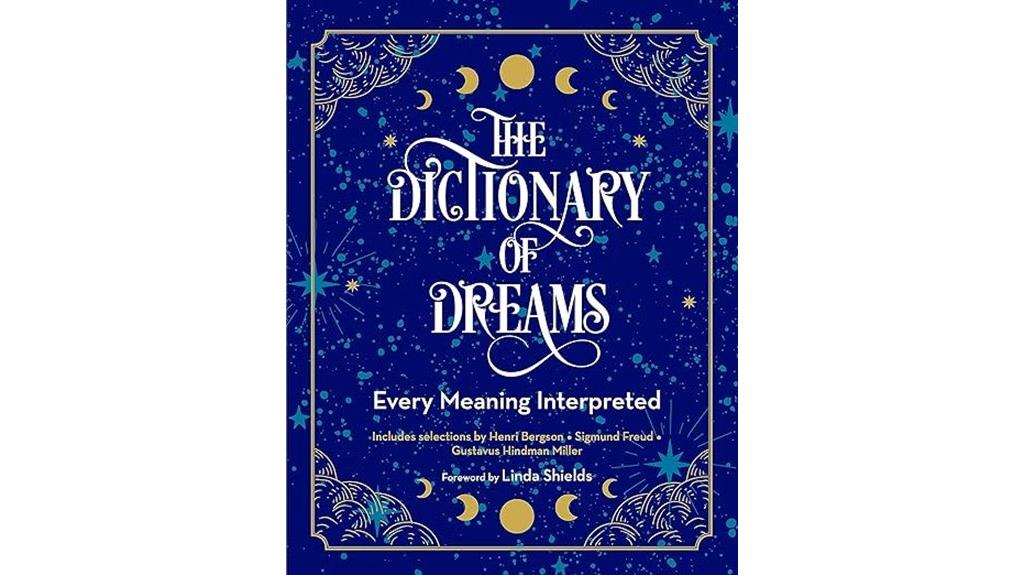
The Dictionary of Dreams Volume 2 stands out as a visually appealing reference for those who appreciate beautifully designed books with detailed dream symbolism. I find it perfect as both a decorative piece and a practical guide, thanks to its stunning illustrations and elegant gold accents. It offers a wide range of dream examples, from curtains to marmalade, with interpretations that many find accurate and insightful. However, some entries are brief or confusing, which can be frustrating. Despite its limitations, I enjoy revisiting this book for inspiration and aesthetics, making it a charming addition to any dream enthusiast’s collection.
Best For: those who appreciate beautifully designed, visually appealing books that offer a decorative touch as well as basic dream symbolism insights.
Pros:
- Stunning illustrations and elegant gold accents enhance aesthetic appeal.
- Provides a wide range of dream examples, from common to obscure symbols.
- Serves as both a decorative piece and a practical reference for dream interpretation.
Cons:
- Entries can be brief, confusing, or lacking depth, limiting usefulness.
- Some interpretations are overly negative or not user-friendly.
- Missing key words or symbols can restrict comprehensive understanding.
Dreamers Dictionary
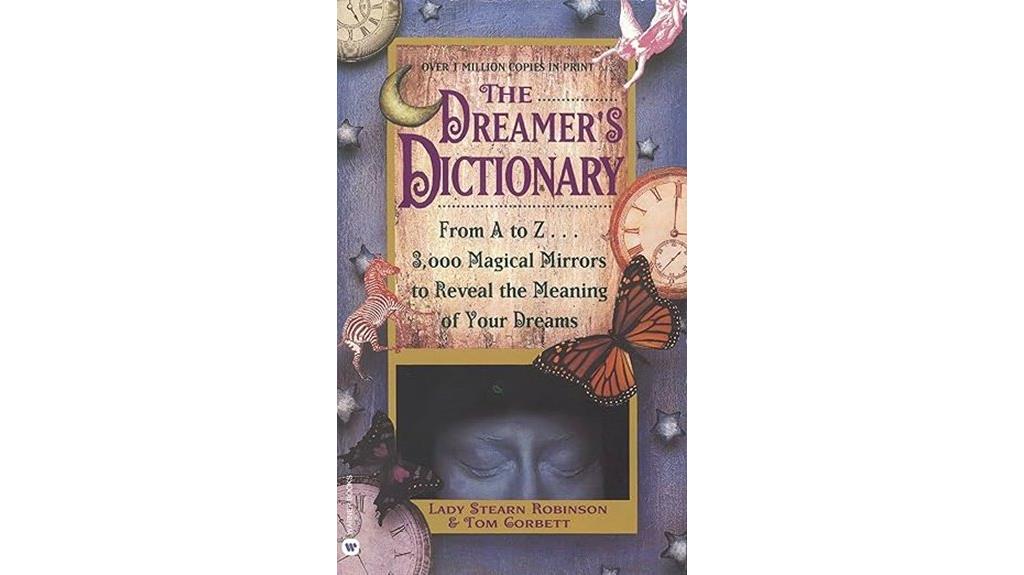
Dreamers Dictionary stands out as the ideal choice for those seeking quick, straightforward interpretations of their dreams. I’ve used it for years, keeping it bedside for instant reference during vivid or confusing dreams. Its alphabetized, no-nonsense format makes looking up symbols like teeth or nightmares simple and efficient. Users report that it provides accurate explanations that help them understand subconscious messages, offering reassurance and emotional relief. Many recommend it as a reliable, affordable resource to complement other psychology or dream books. Its concise, clear definitions make it perfect for anyone wanting to decode dreams without fuss, making it a trusted tool in my own dream exploration.
Best For: individuals seeking quick, straightforward dream interpretations to understand subconscious messages and find reassurance without complex analysis.
Pros:
- Clear, concise, and alphabetically organized for easy look-up
- Accurate and reliable explanations that aid emotional relief
- Affordable and well-suited for personal bedside use over many years
Cons:
- Limited depth; may not satisfy those seeking in-depth psychological analysis
- Primarily available in English, potentially limiting accessibility for non-English speakers
- Slight variations in editions could lead to minor discrepancies in content
Dream Meanings Dictionary of Symbols & Interpretations
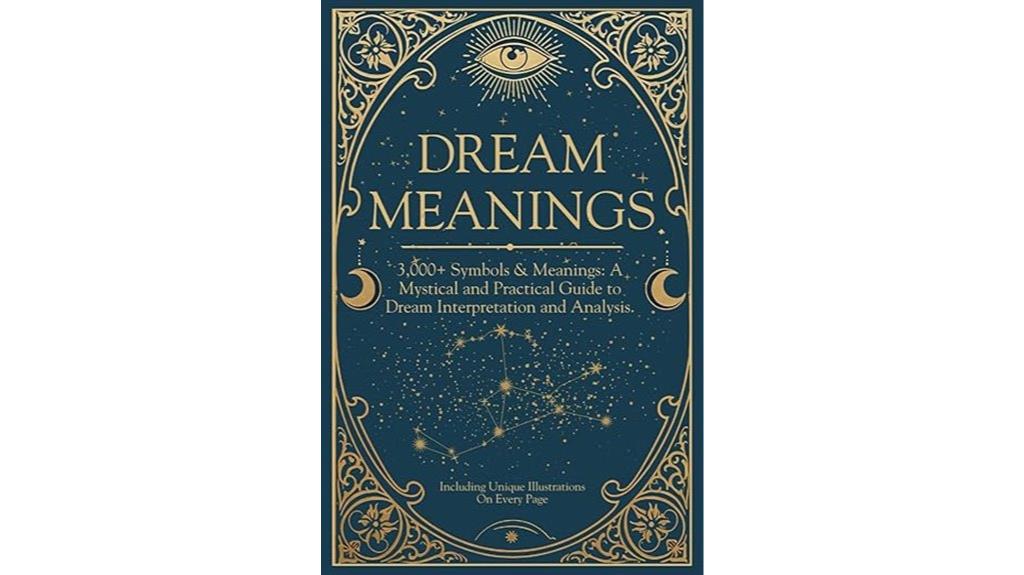
For anyone seeking a straightforward and practical guide to understanding their dreams, the Dream Meanings Dictionary of Symbols & Interpretations offers an accessible resource. It features over 3,000 symbols and meanings, organized alphabetically for quick reference. The entries are clear, simple, and designed to spark reflection without overwhelming you. Beautiful illustrations add emotional depth, making it a visually engaging tool. Many use it daily to interpret recurring themes or explore subconscious messages. While interpretations are meant to inspire rather than dictate truths, it’s a handy, beginner-friendly resource perfect for starting a dream journal or enhancing your understanding of dreams in 2025.
Best For: beginners and dream enthusiasts seeking a practical, easy-to-use guide to understanding dream symbols and meanings.
Pros:
- Clear, simple entries that are accessible for all readers
- Beautiful illustrations that enhance emotional connection and understanding
- Organized alphabetically for quick reference and ease of use
Cons:
- Some users find the font and background images difficult to read, especially on darker backgrounds
- Lacks detailed explanations of the author’s interpretive perspective or credentials
- Limited space for personal notes, which could help deepen individual reflection
The Penguin Dictionary of Symbols (Dictionary, Penguin)

Looking for a resource that offers thorough, culturally diverse insights into symbols without relying on visuals? The Penguin Dictionary of Symbols is perfect. With over 1,150 pages, it covers symbols from world mythology, religion, folklore, and even tarot cards like the Hanged Man. Its detailed, text-based entries focus on meanings, cultural contexts, and interpretations, making it ideal for serious students, psychologists, and literature lovers. While lacking images, its all-encompassing descriptions provide deep understanding of symbols from around the globe. It’s a trusted, scholarly reference that helps decode dreams, art, and literature without visual distractions, emphasizing the richness of symbolic meanings.
Best For: serious students, psychologists, literature enthusiasts, and researchers seeking an in-depth, text-based exploration of symbols from diverse cultures without visual aids.
Pros:
- Extensive and comprehensive coverage of symbols from world mythology, religion, folklore, and tarot.
- Scholarly, well-researched, reliable information suitable for academic, therapeutic, and literary use.
- Clear, alphabetically arranged entries that facilitate quick and easy research.
Cons:
- Lacks visual content or illustrations, which may be a drawback for visual learners.
- Dense and text-heavy, potentially overwhelming for casual readers or beginners.
- No images may limit immediate visual recognition of symbols, requiring interpretative reading.
The Book of Symbols. Reflections on Archetypal Images

The Book of Symbols. Reflections on Archetypal Images is an exquisite, hardcover reference packed with over 800 pages of high-quality materials. Its color-coded sections, foil accents, and artwork reproductions make it both beautiful and functional, perfect for quick consultation or display. Organized like a dictionary, it offers accessible essays on symbols, archetypes, and mythological themes, providing historical insights rather than superstition. Ideal for artists, writers, and researchers, it helps decode dreams, art, and mythology through a Jungian lens. While some may find the text superficial, its illustrations and all-encompassing approach make it a treasured, inspiring resource for exploring the subconscious.
Best For: artists, writers, scholars, and enthusiasts interested in exploring symbols, archetypes, and mythological themes for inspiration, analysis, and personal insight.
Pros:
- Rich, high-quality visual reproductions and artwork enhance understanding and inspiration.
- Organized like a dictionary, making it easy to navigate and find quick references.
- Offers research-based, historical interpretations that deepen insight beyond superstition.
Cons:
- Text may be somewhat superficial, resembling introductory rather than in-depth research.
- Illustrations, while beautiful, are limited in selection according to some users.
- Small font size can make reading challenging for some readers.
Factors to Consider When Choosing a Dream Symbol Dictionary

When choosing a dream symbol dictionary, I look for a solid biblical foundation that aligns with my beliefs. I also consider how detailed the content is, how easy it is to use, and whether it covers a wide range of symbols with practical examples. These factors help me find a resource that’s both reliable and helpful for understanding my dreams.
Biblical Foundation
Choosing a dream symbol dictionary with a solid biblical foundation is essential for accurately interpreting dreams from a faith-based perspective. Such resources derive their meanings directly from scripture, ensuring interpretations align with biblical principles and teachings. They emphasize understanding symbols within their spiritual and theological context, often referencing biblical stories, characters, and events. This foundation helps me discern divine messages in my dreams, fostering spiritual growth and biblical literacy. Unlike dictionaries that include mystical or pagan ideas, biblical-based ones focus solely on biblical symbolism and God’s language as revealed in the Bible. Having this strong biblical foundation provides credibility and trustworthiness, making it especially valuable for Christians seeking to interpret dreams through a biblical worldview. It keeps interpretations rooted in God’s Word.
Content Depth
A detailed dream symbol dictionary offers explanations that go beyond simple definitions, providing cultural or biblical context to deepen your understanding. Shallow or vague entries can limit your ability to interpret dreams accurately and may lead to misunderstandings. The depth of content often reflects the complexity of symbols; more nuanced descriptions reveal layered meanings, enriching your insights. Resources with rich, elaborative explanations tend to be more useful for personal growth and spiritual development. Additionally, consider whether the dictionary includes cross-references or related symbols, as this can help you see connections and develop a more holistic view of your dream messages. Ultimately, a exhaustive, well-explored content depth enables you to decipher greater meaning from your dreams.
Usability & Layout
Selecting a dream symbol dictionary with a clear and organized layout can make a significant difference in how easily you find and understand symbols. I look for books with alphabetic or categorized entries, which streamline navigation and save time. Usability is further improved when the book offers practical tools like step-by-step interpretation guides or prompts for personal reflection, helping me deepen my insights. Visual features such as illustrations or color-coding enhance understanding, especially for visual learners like myself. Readability matters too; clear fonts, proper sizing, and overall design ensure comfortable reading, even for those with visual challenges. A user-friendly layout also includes space for notes, allowing me to document my interpretations and track my progress over time.
Symbol Coverage
When looking for a dream symbol dictionary, it’s essential to contemplate how thoroughly it covers a wide array of symbols from different cultures and contexts. I look for resources that include diverse symbols—objects, animals, colors, numbers, and abstract themes—to guarantee a comprehensive understanding. Detailed explanations and biblical references are crucial for supporting spiritual interpretations. I also prioritize clear, concise definitions that are easy to grasp and apply in dream analysis. Additionally, I seek dictionaries that offer contextual insights or examples, helping me interpret symbols accurately within dreams or visions. This broad coverage not only enriches my understanding but also allows me to explore personal and spiritual meanings more effectively, making the dictionary a versatile tool for revealing subconscious messages.
Practical Examples
Practical examples of dream symbols are essential because they help me see how interpretations can vary based on context and personal experience. For instance, a snake might represent temptation in one dream but transformation in another, depending on the situation. Noticing recurring symbols like doors or water shows me the importance of consistency and personal relevance when choosing a dictionary. Analyzing dreams involving objects like keys reveals how specific symbols can guide me toward the right reference, especially if they symbolize access or control. Comparing interpretations across different cultures highlights the need for a dictionary that offers diverse, real-world examples. Testing these interpretations with actual dream reports ensures I select a resource that provides practical, applicable insights for my personal understanding.
Author Expertise
Choosing a dream symbol dictionary that’s truly reliable starts with examining the author’s expertise. I look for authors with strong backgrounds in biblical studies, psychology, or symbolism to verify interpretations are accurate and meaningful. Credentials, published works, and recognition within spiritual, theological, or academic circles help gauge their credibility. An expert with a deep understanding of cultural and historical symbolism can offer richer, more nuanced insights into dreams. It’s also essential to contemplate whether the author’s approach aligns with my beliefs—whether biblical or psychological—so I can apply the interpretations effectively. I value authors who incorporate biblical references, scholarly research, or biblical examples, as these lend depth and trustworthiness to their insights, making the dictionary a more reliable guide to my subconscious.
Frequently Asked Questions
How Do Cultural Differences Influence Dream Symbol Interpretations?
Cultural differences deeply influence how I interpret dream symbols because my background shapes what certain images or themes mean to me. For example, a snake might symbolize danger in my culture but represent wisdom elsewhere. I always consider cultural context because it helps me understand the personal and collective meanings behind my dreams more accurately, making my interpretations richer and more meaningful.
Can Personal Experiences Alter the Meanings of Universal Symbols?
Absolutely, personal experiences can change how I interpret universal symbols. What a snake means to me might differ from someone else based on my life events, fears, or memories. I find that my feelings and past shape my understanding of symbols, making my dreams uniquely mine. So, while universal symbols offer guidance, my personal context adds depth and nuance to their meanings.
Are There Specific Symbols Unique to Certain Religious Traditions?
Yes, there are symbols unique to specific religious traditions that can deeply influence your dreams. I’ve seen how a cross, crescent, or lotus can carry profound spiritual meaning, depending on your beliefs. These symbols often evoke powerful subconscious messages tied to faith, culture, and personal spirituality. Recognizing them can uncover hidden insights, revealing how your faith and traditions shape your inner world in ways you may not have imagined.
How Reliable Are Dream Dictionaries for Understanding Recurring Dreams?
Dream dictionaries can be helpful, but I wouldn’t rely on them entirely for understanding recurring dreams. They offer general insights, but your personal experiences and emotions are key. I find that reflecting on how certain symbols make me feel and what’s happening in my life gives me a clearer picture. Combining dream dictionaries with self-awareness helps me uncover deeper subconscious messages more accurately.
What Is the Best Way to Combine Multiple Dictionaries for Accurate Insights?
To get the most accurate insights, I recommend cross-referencing multiple dream dictionaries and noting common themes. Think of it as piecing together a puzzle; each source adds another piece. I keep a journal to track recurring symbols and compare their interpretations. This way, I avoid putting all my eggs in one basket and gain a well-rounded understanding of my dreams, making the symbols more meaningful and personal.
Conclusion
Did you know that over 85% of people believe dreams hold personal or spiritual meaning? Exploring these dream symbol dictionaries can open your subconscious and offer profound insights. Whether you’re seeking biblical guidance or universal symbols, there’s a perfect book for you. Immerse yourself in these top 14 options and start decoding your dreams today—trust me, understanding your dreams can truly transform your self-awareness in 2025 and beyond.









